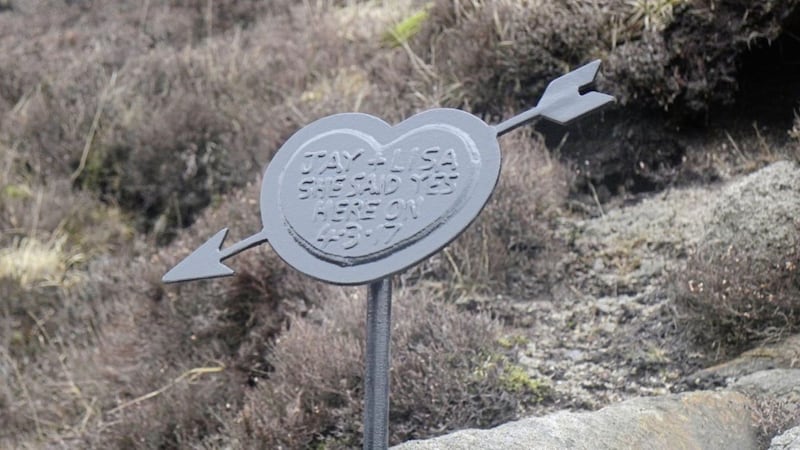THE great Irish poet Patrick Kavanagh once wrote that "to know fully even one field or one land is a lifetime's experience".
"In the world of poetic experience it is depth that counts, not width," he wrote.
"A gap in a hedge, a smooth rock surfacing a narrow lane, a view of a woody meadow, the stream at the junction of four small fields - these are as much as a man can fully experience."
We know that being able to look at nature, even if we cannot always be in it, does us good. Seeing daffodils bloom in a park or listening to the blackbird that often sits on my roof can lift the most mundane of days.
I couldn't help but remember Kavanagh's words when The Irish News reported last week about a couple who had put up a sign in the Mourne Mountains to mark their recent engagement.
A heart-shaped sign was put on the Brandy Pad, beneath the Castles on the south-western slopes of Slieve Comedagh. "Jay + Lisa, she said yes here on 4.3.17," it reads.
The couple, clearly excited by their engagement, put up the sign with the best of intentions. It's not unusual to see banners on hedges and roadsides marking people's birthdays.
Why shouldn't they leave a more permanent reminder of a happy event? Other people have left mementos in the Mournes - some to departed loved ones.
Yet these human traces, however well-meant, do raise questions about how we treat our landscape and particularly our wildest areas.
To walk through the Mournes is to walk through an ancient landscape, some of it formed hundreds of millions of years ago.
Volcanic activity and at least six ice ages helped shape the mountain range. Even being in the landscape helps you realise man's relative insignificance.
With such riches on our doorstep, it seems strange that anyone could think that a man-made sign would improve the view.
But perhaps that wasn't the intention. In the last few decades our society has become obsessed with display and show. It seems as though it's not enough to experience something, that experience needs to be displayed, photos need to be taken to prove you were there, then the pictures must be posted on social media.
But it's not just photos. Some people seem to believe that they must leave a physical reminder, a mark that they too walked this street or visited that landmark.
To be fair even ancient Athens was blighted by graffiti, but since our world's population has grown we have begun to leave a bigger mark.
In Paris, several of its main bridges have been spoiled by millions of 'love locks'. It had become a tradition for tourists to fasten a lock to the Pont des Arts before throwing the key into the River Seine.
The locks were meant to be a symbol of everlasting love but they also damaged the pedestrian bridge. In 2015 part of the bridge's railings collapsed under the sheer weight.
Venice has also had difficulties with tourists attaching 'love locks' to the Rialto bridge, a practice which writer Alberto Toso Fei rather cuttingly described as "an act of vandalism" and not the "expression of a unique sentiment, but an action that is totally banal".
If man-made structures are weakening under the weight of mementos then what chance does our natural world have?
Hill-walkers, campers, fell-runners and many others who enjoy and spend much of their recreation outdoors have long tried to abide by the 'leave no trace' rule.
People are encouraged to dispose of their waste, respect wildlife, show consideration to other visitors and, most importantly, leave an area as you found it. The rule suggests that it's enough to take a walk in ancient mountains without feeling that we need to leave a mark.
Kavanagh wrote about depth, about what a "man can fully experience" - experience being something within, something which seems to be the opposite of putting up signs, the opposite of show.
It's perfectly possible to live in the world without experiencing it. How many of us have seen people take dozens of pictures, rather than looking at the view?
But it would be a waste if we didn't try and experience the landscape on our doorstep. The Mournes have been here millions of years before any of us existed and will remain long after we die.
We should visit them, enjoy them, but leave no trace.








